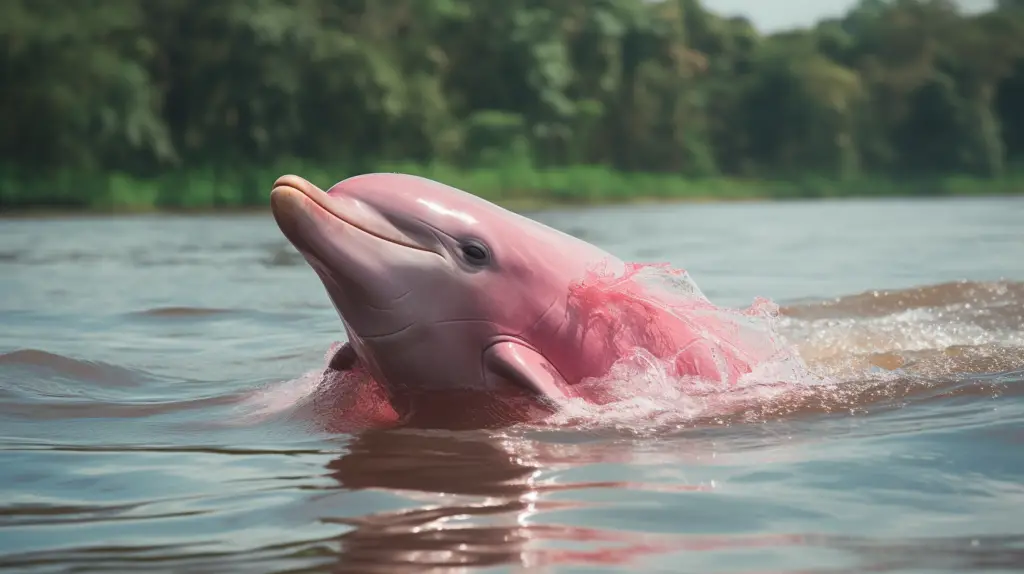A world of fascinating creatures resides beneath the Earth’s waves, one of which is the extraordinary Pink Dolphin, or Amazon River Dolphin, known scientifically as Inia geoffrensis. This species is intriguing for a multitude of reasons, not least its unique, eye-catching hue.
What follows is a collection of 25 exciting facts that shine a light on the enigmatic world of these dolphins, providing a fascinating look into their biology, behavior, and their unique place in both local and global ecosystems.
1. Unique Coloration: The Pink Dolphin is indeed pink – an incredibly unique characteristic among cetaceans. Their color can range from a light, blush pink to a bright, almost flamingo-like hue.
2. Color Changes With Age and Mood: Interestingly, a pink dolphin’s color can change with age or mood. Young dolphins tend to be gray, and they become pinker as they age. Moreover, when they are excited, their color can intensify.
3. Habitat: They inhabit the freshwater systems of the Amazon and Orinoco River basins in South America, making them the most widespread river dolphin species.
4. Size: They are among the largest of the freshwater dolphins, reaching lengths of 6 to 8 feet and weighing between 185 to 400 pounds.
5. Unusual Fins: Pink Dolphins have uniquely large dorsal fins relative to their body size, which is thought to help with maneuverability in their complex riverine environments.
6. Flexible Neck: Unlike most other dolphin species, Pink Dolphins have unfused neck vertebrae, which gives them a uniquely flexible neck and the ability to turn their heads 180 degrees.
7. Diet: They are omnivores, and their diet includes over 50 different species of fish, including piranhas, catfish, and even small turtles.
8. Echolocation: Like other dolphins, they use echolocation to navigate their often murky river habitats and to find food.
9. Social Behavior: While Pink Dolphins can be found in groups, they are often seen alone or in small groups of 2-4 individuals.
10. Long Life Span: Pink Dolphins can live up to 30 years in the wild.
READ MORE: 25 Interesting Facts about Tigers and International Tiger Day
11. Slow Reproduction Rate: Female Pink Dolphins only give birth to a single calf every two to three years after a gestation period of up to 11 months.
12. High Intelligence: They are highly intelligent, showing problem-solving abilities and tool use.
13. Threats: Pink Dolphins face several threats, including habitat destruction, pollution, accidental capture in fishing nets, and hunting for use as bait in catfish fisheries.
14. Endangered Status: Due to these threats, they are classified as Endangered by the International Union for Conservation of Nature (IUCN).
15. Poor Eyesight, Excellent Hearing: Despite their murky habitat, Pink Dolphins have poor eyesight but an excellent sense of hearing.
16. Unique Mating Rituals: During courtship, male Pink Dolphins present females with gifts, usually sticks or clumps of weeds.
17. Symbolism: In local folklore, they are often seen as shapeshifters or enchanted creatures with magical powers.
18. Conservation Efforts: There are now various conservation efforts in place to protect Pink Dolphins, including laws to prevent hunting and initiatives to protect their habitat.
19. Breeding Season: Pink Dolphins have a distinct breeding season, which varies depending on the region but usually occurs during the flood season.
20. Ability to Swim Backwards: Their unique body shape allows them to swim both forwards and backwards.
READ MORE: 25 Interesting Facts about Orcas, or Killer Whales
21. Camouflage: Their pink coloration is thought to act as camouflage in the red, brown, and white waters of the Amazon and Orinoco rivers.
22. Molar Teeth: They have specialized molar teeth to crush their hard-shelled prey.
23. Seasonal Migration: Pink Dolphins migrate seasonally in response to changes in water levels within the Amazon basin.
24. Local Names: In Brazil, they’re often referred to as “boto,” while in Peru, Ecuador, and Colombia, they’re known as “bufeo.”
25. Ecological Importance: As apex predators, Pink Dolphins play a crucial role in maintaining the balance of their ecosystem by controlling the populations of various prey species.
READ MORE: 25 Amazing Facts About MANGROVE FORESTS
Pink Dolphins are an utterly unique species, captivating in both their behavior and appearance. These 25 facts offer just a glimpse into their fascinating world. As these animals continue to face threats in their native habitats, it becomes even more important to understand and appreciate them, emphasizing the need for robust conservation efforts to ensure their survival for future generations.



